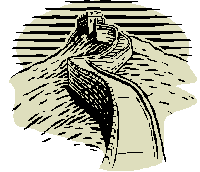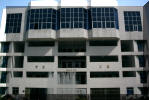
Impressions from China
 |
Impressionen aus China Impressions from China |
| These pages are dedicated to our hosts of
the School for the Blind in Wuhan, who showed us their wonderful school,
city and culture. From left: Two principals, Tan Shu Ya, Tanja, me, Huang Haiping and the principal Mr. Jiang Diese Seiten
sind unseren Gastgebern von der Blindenschule in Wuhan gewidmet, die
uns ihre wunderbare Schule, ihre Stadt und ihre Kultur gezeigt haben. |
Wuhan
We left Beijing for Wuhan by night train on the evening of March 17th. Tanja, who accompanied me there, and I took from the campus and showed the driver a slip of paper with "Take us to Western railway station" written in Chinese. I also had a city map on my knees to discourage any "sightseeing" trips, and we arrived without a problem. Finding the right platform was the next challenge. The display was full of chinese characters, but the arabic numbers indicating time and platform gave us a good idea, confirmed by a person at the service desk.
Wuhan is 1200 km south of Beijing on the banks of the Yangzi river (or Chang Jiang, as it is called in China). We arrived there early in the morning and where welcomed by Huang Haiping, a massage teacher from the school, Tan Shu Ya, who introduced herself as Julia and was our interpreter, and a man who drove the van (We never learned his name).
Chinese breakfast is very different from western. There were beans and other vegetables, spring rolls, steamed stuffed buns (similar to Dim Sum), spicy noodles and different kinds of sweet soups. I've always preferred spicy food for breakfast, and I enjoyed these meals throughout our time in Wuhan.
The school
  |
The school building is light-flooded and has a friendly atmosphere. |
| The boy reads and writes Braille. He uses slate and
stylus to write, which is now rarely done in Europe or North America. But
braillewriters are expensive and the Wuhan school had only a few. For more
info on Braille see
Braille Technology. The girl uses an abacus to calculate. It is widely used by all students in China, and they reach a high efficiency. |
|
| Music is another important subject.The school has many talented students who perform across the city. We got to see a performance and pictures of the students, teachers and us were taken afterwards. |
|
The City
Wuhan has three major parts that once where independent cities of their own: Wuchang, Hankou and Hanyang. It has a population of over 7 million people. The school and our Hotel were situated in Wuchang.
| The town's landmark is the Yellow Crane Tower. It sits amid the city on Snake Mountain, surrounded by a park. In the second image you see the park with the city in the background. |
|
|
|
While we enjoyed the warm spring weather in Wuhan, a sandstorm hit Beijing. We were really lucky... |
When Tanja and me had to leave Wuhan for Beijing after five days, we felt that the time had been way too short. We had only begun to understand the rich and unfamiliar chinese culture. I am immensely grateful for the hospitality we experienced there, and for the grace and patience with which our ignorance of their customs was met. I sincerely hope to go back one day.
Thanks!